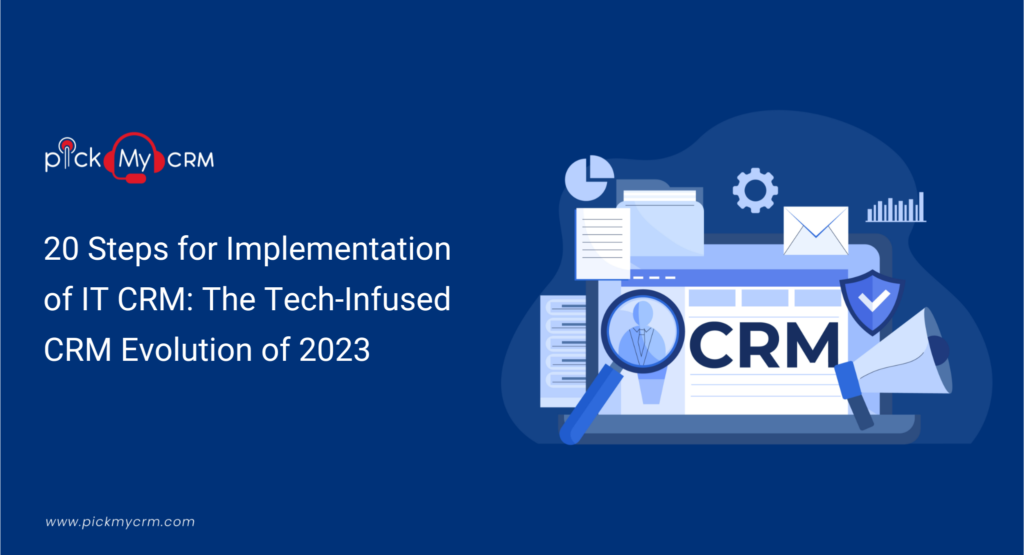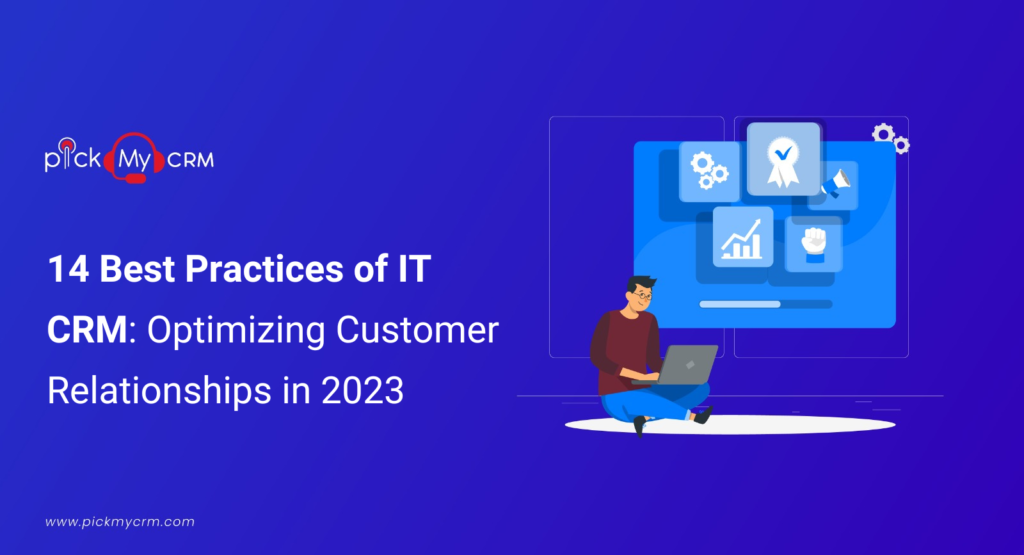20 Steps for Implementation of IT CRM: The Tech-Infused CRM Evolution of 2023
How Does IT CRM Implementation Work?
IT CRM implementation operates through a meticulous fusion of technology and strategy. By utilizing tools like AI, data analytics, and automation, businesses gather and process customer data to glean valuable insights. These insights inform personalized marketing campaigns, predictive maintenance, and proactive customer support. Automation streamlines processes, ensuring timely interactions and freeing up human resources for high-impact tasks. The result is an ecosystem where technology optimizes customer interactions, driving satisfaction, retention, and growth.20 Successful Steps for Implementation of IT CRM
Implementing an IT Customer Relationship Management (CRM) system is crucial for enhancing customer satisfaction and streamlining your business processes. Here are steps to ensure a successful implementation,Define Clear Objectives
Clearly defining objectives is vital for implementing an IT Customer Relationship Management (CRM) system. These objectives provide direction and purpose, ensuring all stakeholders understand the project's goals. Specify your goals clearly, using detailed language. Establish measurable metrics and KPIs for progress tracking. Ensure objectives are realistic and relevant to your organization's strategy. Set timeframes for each goal to create urgency. Prioritize objectives based on their impact and align them with stakeholder needs and expectations. Examples of clear objectives for CRM implementation might include,- Increase customer retention by 15% within the first year.
- Reduce response times to customer inquiries by 20% within six months.
- Improve lead conversion rates from marketing campaigns by 10% in the next quarter.
- Achieve a 95% accuracy rate in customer data within three months.
Get Executive Buy-In
- Communicate the Benefits: Clearly articulate the benefits of implementing the CRM system to the executives. Highlight how it aligns with the organization's strategic goals, such as increasing revenue, improving customer satisfaction, or streamlining operations.
- Provide a Business Case: Prepare a well-researched business case that outlines the ROI (Return on Investment) and the long-term advantages of CRM adoption. Incorporate data and substantiating evidence to bolster your assertions.
- Engage Executives Early: Involve executives in the planning phase. Seek their input and address any concerns or questions they may have. This early involvement can build their confidence in the project.
- Demonstrate Success Stories: Share success stories or case studies of other organizations that have benefited from CRM implementations. Emphasize the positive impact on customer relationships and bottom-line results.
- Allocate Resources: Ensure that Executives understand the resource requirements, including budget, time, and personnel, needed for the CRM implementation. Be transparent about the investment.
Assemble a Dedicated Team
- Cross-Functional Team: Form a team with members from various departments, including IT, sales, marketing, and customer support. Incorporating a range of diverse perspectives guarantees the inclusion of all pertinent viewpoints.
- Project Manager: Appoint an experienced project manager who can oversee the CRM implementation. This person should possess robust leadership and organizational abilities.
- Subject Matter Experts: Engage team members who Possess expertise in CRM technology, business processes, and customer engagement, as they can offer valuable insights.
- End Users: Involve end users early in the process to Gather input and ensure the CRM system meets their needs. It also helps with user adoption later on.
- Training and Support: Identify team members responsible for Training and providing ongoing support to users after implementation. User training is crucial for successful adoption.
- Clear Roles and Responsibilities: Establish explicit roles and responsibilities for every team member. It minimizes confusion and ensures that everyone knows their tasks.
- Collaborative Culture: Foster a collaborative and open culture within the team. Encourage open communication and the sharing of ideas and feedback.
Conducting Needs Assessment for IT CRM Implementation
Carrying out a thorough needs assessment is a crucial step in ensuring the successful implementation of an IT CRM system. This process involves evaluating your organization's current state, identifying pain points, and determining what specific requirements the CRM system should address.- Analyze Current Processes
- Gather Stakeholder Input
- Identify Pain Points
- Define Objectives
- Determine Data Requirements
- Assess Integration Needs
- Identify User Requirements
- Consider Scalability
- Ensure Compliance and Security
- Allocate Budget and Resources
- Define Implementation Timeline
- Conduct Risk Assessment
- Evaluate CRM Vendors if needed.
Preparing for Implementation
In the prelude to embarking on the voyage of IT CRM implementation, meticulous preparation serves as the compass. A comprehensive needs assessment, akin to cartographic exploration, charts the landscape of business requirements, uncovering hidden crevices of necessity. Similar to the craftsmanship of skilled artisans, the implementation strategy takes form with meticulous precision, crafting blueprints that chart the course ahead. Assembling a capable team of experts mirrors a group of skilled artisans, guaranteeing that the implementation journey is navigated and illuminated by their collective expertise.Selecting the Right IT CRM Solution
Within the expansive marketplace of technological offerings, selecting the ideal IT CRM solution requires discernment akin to that of a connoisseur. Vendors beckon with offerings, each a canvas of promise. Yet, the discerning eye delves beyond the allure, probing the depths of customization and integration capabilities. Scalability, a trait akin to a phoenix's rebirth, becomes a pivotal criterion, ensuring that the chosen solution resonates with the business's trajectory.Data Migration and Cleansing
As legacy systems fade into the horizon, data migration emerges as the conduit to the future. Precision akin to cartography is essential, carefully charting existing data structures onto the new terrain. The resounding imperative of accuracy and completeness echoes, necessitating a purification ritual for data repositories. However, amid this endeavor, obstacles might arise—much like capricious winds, managed with skill and guided by an unwavering commitment to the ultimate goal.The Impact on Customer Retention
Amidst the fiercely competitive market terrain, the retention of customers has emerged as a pivotal metric for gauging business triumph. Implementing an IT CRM system enables companies to anticipate customer needs, offer timely solutions, and provide personalized recommendations. As a result, businesses have experienced a substantial 25% increase in customer retention rates. By nurturing existing customer relationships and addressing concerns before they escalate, companies create a sense of loyalty and trust that resonates with clients, reducing churn and establishing a stable revenue stream.Driving Sales Growth to New Heights
The fusion of IT and CRM has revolutionized the arena of driving sales expansion. By tapping into data-driven insights, enterprises unveil cross-selling and upselling opportunities fine-tuned to the preferences of each customer. Furthermore, automation integrated within the IT CRM ecosystem streamlines sales procedures, empowering sales teams to dedicate their efforts to high-value tasks rather than administrative duties. The outcome? A notable 35% surge in total sales figures, as indicated by companies embracing this pioneering strategy.Enhancing Customer Experience
In the era of instant gratification, delivering exceptional customer experiences is non-negotiable. IT CRM empowers enterprises to provide tailored interactions across diverse communication channels, spanning social media, email, and live chat. AI-driven chatbots provide real-time assistance, resolving queries promptly and improving response times. This heightened level of engagement delights customers and boosts brand loyalty, as satisfied customers are more likely to become brand advocates.Customization and Configuration
The realm of IT CRM flourishes with the allure of customization—a canvas chosen to paint a business's unique identity. The brushstrokes of configuration mold the solution into a bespoke masterpiece, reflecting the contours of business requirements. User roles are meticulously etched, and access permissions serve as gates within a fortified citadel. Workflow processes dance in harmonious choreography, orchestrating efficiency.User Training and Adoption
The IT CRM solution resembles an instrument, and user training evolves into a symphony. An orchestrated program Unfolds, as intricate as a composer's opus. Users transform into virtuosos, wielding the tool with mastery. As engagement reaches its crescendo and the melody of adoption resounds, users discover harmony with the new tools. Metrics undergo meticulous tracking, Ensuring the consistent maintenance of accurate records for user adoption notes.Integration with Existing Systems
In the grand orchestra of business systems, integration assumes the role of the conductor's baton. IT CRM harmonizes with ERP, marketing, and sales systems—each note resonating in Synchrony. Data flows seamlessly, and real-time insights come to life. Amid the resonant melodies, challenges may arise, yet a skilled conductor navigates them with grace.Change Management Strategies for Successful IT CRM Implementation
Within the realm of change, resistance may linger like shadows. Communication is the lantern that dispels darkness, illuminating the benefits of IT CRM implementation. The cultural shift, akin to a wind change, is nurtured. Fostered within the fertile soil of change, an environment of continuous improvement flourishes—a garden of growth.Testing and Quality Assurance
Testing and Quality Assurance form the bedrock of software development, guaranteeing reliability and user satisfaction. Rigorous testing processes meticulously examine software components, ensuring seamless functionality and optimal performance. Quality Assurance surpasses testing, integrating best practices, precise standards, and ongoing enhancement to enhance the entirety of the development process. Collectively, these approaches cultivate dependable, streamlined, and user-centric solutions that propel business achievements. Quality Assurance Best Practices- Clear Standards: Set precise quality benchmarks to guide development teams and maintain consistency.
- Collaboration: Cultivate effective communication among developers, testers, and stakeholders to synchronize expectations.
- Feedback Loop: Establish continuous feedback loops to address issues promptly and enhance the development process.
- Documentation: Maintain thorough documentation of testing processes, results, and any necessary changes.




